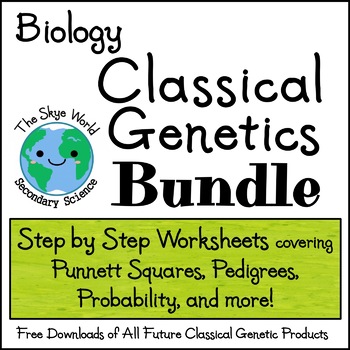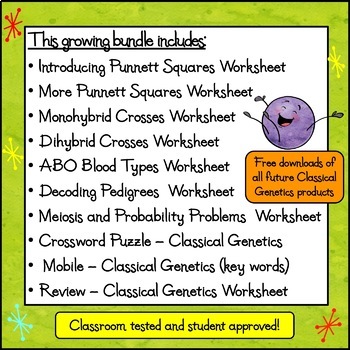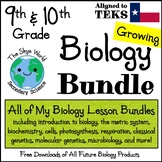Bundle of Lessons - Classical Genetics and Heredity
- Zip
- Internet Activities
- Easel Activity
Products in this Bundle (14)
showing 1-5 of 14 products
Also included in
- This growing bundle of lessons for 9th and 10th grade biology includes the metric system, biochemistry, cells, photosynthesis, respiration, cell division, heredity, and classical genetics. Bundles include notes, worksheets, lab activities, card sorts, task cards, digital Boom cards, review sheets,Price $191.00Original Price $317.00Save $126.00
Description
In this growing bundle of lessons, students will learn to set up Punnett squares, solve probability problem, and decode pedigrees. This bundle will also prepare biology students on the topics of types of inheritance, ABO blood types, codominance, monohybrid and dihybrid crosses, and the laws of inheritance.
Important Information
- Answer keys included
- Includes activities recommended for 7th grade science, biology, and AP biology classes
Included in this bundle – click to see details
- Introduction to Punnett Squares – Step by StepWorksheet
- More Punnett Squares – Step by Step Worksheet
- Punnett Squares for Monohybrid Crosses – Step by Step Worksheet
- Punnett Squares for Dihybrid Crosses – Step by Step Worksheet
- ABO Blood Typing Foldable with Powerpoint presentation
- ABO Blood Typing with Punnett Squares Worksheet
- Decoding Pedigrees Worksheet
- Meiosis and Probability Problems Worksheet
- Crossword Puzzle – Classical Genetics
- Vocabulary Mobile – Classical Genetics
- Review – Classical Genetics Worksheet
- Halloween Science Activity Using Genes to Build a Jack O' Lantern
- Building Thanksgiving Turkeys Using Punnett Squares Activity
TEKS Covered
7.14A
7.14B
B.6F
B.6G
NGSS Standards Covered
MS-LS3-2
HS-LS3-1
HS – LS3-2
HS-LS3-3
Related Resources
- Bundle of Lessons – Molecular Genetics - DNA, RNA, and Protein Synthesis
- Bundle of Lessons – Photosynthesis and Cellular Respiration
- Bundle of Lessons - Biochemistry
Terms of Use – copyright ©Catherine Skye All rights to this product are reserved by author. This authorizes one teacher to use this product. If you want to share it with other teachers, please purchase a license to share this work. Copying by more than one teacher, classroom, department, school, or school system is prohibited UNLESS you purchase a license. Clipart and elements found in this PDF and others on my site are from the public domain unless otherwise noted. All products on my site are intended for classroom and personal use and may not be digitally copied for reuse in any form. Any misuse is considered copyright infringement and violates the DMCA (Digital Millennium Copyright Act).






